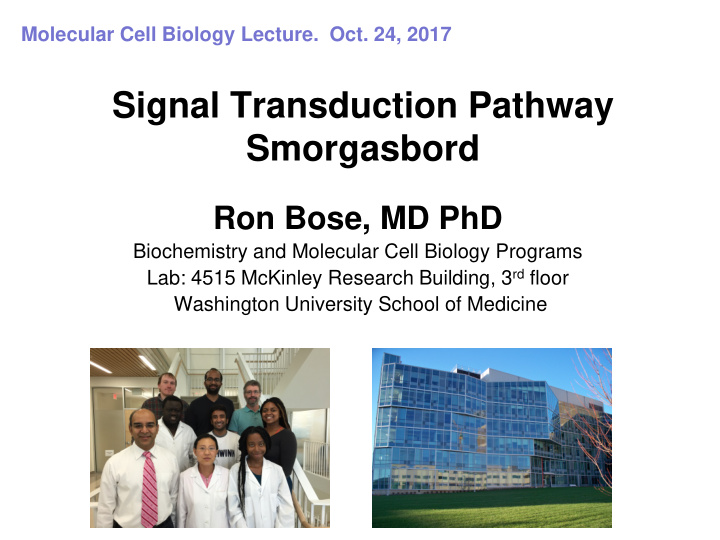



Molecular Cell Biology Lecture. Oct. 24, 2017 Signal Transduction Pathway Smorgasbord Ron Bose, MD PhD Biochemistry and Molecular Cell Biology Programs Lab: 4515 McKinley Research Building, 3 rd floor Washington University School of Medicine
What is the connection? Signal Transduction
Outline 1. Nuclear Hormone Receptors 2. Cytokine Receptors – JAK/STAT Pathway 3. PI3-kinase – Akt – mTOR 4. Regulation of Protein Kinases
Resources: Nuclear Hormone Receptors https://www.nursa.org/nursa/index.jsf Online Course: https://www.nursa.org/nursa/flashTutorial/gene/nu clearReceptor/start.jsf Reference: McKenna NJ and O'Malley BW. An interactive course in nuclear receptor signaling: concepts and models. Sci STKE. 2005 , tr22.
Nuclear Hormone Receptor Superfamily 1. 48 Human genes 2. Major Categories: Thyroid Hormone TR, RAR, PPAR, Vitamin D receptor, LiverX Receptor (TR)- like Receptor Estrogen Receptor (ER)- ER, PR, AR, Estrogen Receptor Related, like Glucocorticoid receptor, Mineralocorticoid receptor Retinoid X Receptor (RXR) RXR, Hepatocyte nuclear factor-4, etc. like Knock-out in mice causes reproductive, developmental, or metabolic abnormalities.
AF: Activation Function. Mediate transcriptional activation DNA Binding Domain Ligand Binding Domain www.nursa.org/
AF: Activation Function. Mediate transcriptional activation www.nursa.org/
Bind as homodimers Bind as heterodimers with RXR Hormone response elements Hormone response elements are inverted repeats. are direct repeats. www.nursa.org/
Ligand Present Ligand Absent www.nursa.org/
Movie: https://nursa.org/nursa/about/tutorial.jsf Tab 12. Nuclear Hormone Action Model www.nursa.org/
Outline 1. Nuclear Hormone Receptors 2. Cytokine Receptors – JAK/STAT Pathway 3. PI3-kinase – Akt – mTOR 4. Regulation of Protein Kinases
Cytokine Receptors – JAK/STAT Pathway Baker et al., Oncogene (2007) 26, 6724–6737
Cytokine Receptors Baker et al., Oncogene (2007) 26, 6724–6737
JAK = Janus kinases 4 genes in humans and mice • TYK2 (first gene in this family to be identified) • JAK1, JAK2, JAK3 Baker et al., Oncogene (2007) 26, 6724–6737
STAT= Signal Transducers and Activators of Transcription Baker et al., Oncogene (2007) 26, 6724–6737
Cytokine Receptors – JAK/STAT Pathway Baker et al., Oncogene (2007) 26, 6724–6737
Recptor Tyrosine Kinases Examples– EGFR, Her2, etc from Marmor, Skaria, and Yarden 2004
Outline 1. Nuclear Hormone Receptors 2. Cytokine Receptors – JAK/STAT Pathway 3. PI3-kinase – Akt – mTOR 4. Regulation of Protein Kinases
PI3-kinase – Akt – mTOR Songet al., Nature Rev Mol Cell Bio 2012
PI3-kinase – Akt PI3K PtdIns(4,5)P 2 PtdIns(3,4,5)P 3 (PIP2) (PIP3) PTEN PDK1 Akt Zoncu et al., Nature Rev Mol Cell Bio 2011
mTOR complexes mTORC1 Rapamycin sensitive Responds to nutrient level, growth factors, energy, and stress. mTORC2 NOT rapamycin sensitive Inputs into mTORC2 less well known. Zoncu et al., Nature Rev Mol Cell Bio 2011
mTORC1 substrates • S6 kinase 1 (S6K1) • eIF-4E binding protein (4E-BP) Zoncu et al., Nature Rev Mol Cell Bio 2011
mTORC2 substrates Akt mTORC2 PDK1 1 2 T308 S473 PH Kinase Domain domain 3 Downstream substrates: TSC complex, PRAS40, etc. Zoncu et al., Nature Rev Mol Cell Bio 2011
Bringing it all together mTOR is a signal integrator, like the chips and circuits in your smart phone Zoncu et al., Nature Rev Mol Cell Bio 2011
Outline 1. Nuclear Hormone Receptors 2. Cytokine Receptors – JAK/STAT Pathway 3. PI3-kinase – Akt – mTOR 4. Regulation of Protein Kinases
More information available at: http://kinase.com/web/current/ Manning et al., Science 2002
Regulation of Protein Kinases 1. Post-translation modifications. Phosphorylation-dependent Activation Loop 2. Protein-protein interactions Regulatory Subunits Dimers
Structure of PKA catalytic domain α Helices β Sheets N-lobe C Helix C-lobe Caplan, Science STKE 2005
Structural features of the PKA Activation Loop Illustration from Nolen et al, Mol. Cell, Vol. 15, p.661-675, 2004
Phosphorylation of the MAP Kinase activation loop • Phosphorylation on threonine and tyrosine • Phospho-Thr 183 contacts α -C and promotes active conformation • Phospho-Thr 183 promotes ERK2 dimerization via conformational changes in C-terminal extension AKT phosphorylation at Illustration taken from Huse and Kuriyan, Cell 109, 275-282 (2002) T308 is also Activation Loop Phosphorylation
MAP Kinase Structure Thr183 Tyr185 Unphosphorylated Phosphorylated Canagarajah et al Cell 90, 859-869 (1997)
MAP Kinase Structure Unphosphorylated Thr183 Phosphorylated Tyr185 Canagarajah et al Cell 90, 859-869 (1997)
Cyclin - Cyclin-dependent kinase (CDK) Complex Cyclin A Cyclin-dependent kinase (Cdk2) Jeffrey et al Nature 376, 313-320 (1995)
Jeffrey et al Nature 376, 313-320 (1995) C-helix C-helix Activation Loop Activation Loop Cdk2 Cdk2.CyclinA
Asymmetric Dimer Formed by the EGFR Kinase Domain EGFR kinase domain asymmetric dimer Zhang, Gureasko, Shen, Cole, and Kuriyan. Cell 2006
Summary 1. Nuclear hormone receptors consist of a DNA- binding domain and ligand-binding domain. 2. Cytokine receptors signal through the JAK kinases, which have 2 kinase domains, and the STAT transcription factors. 3. mTOR is a signal integrator for metabolic and growth factor signaling. 4. Protein kinases are regulated by PTM’s and protein-protein interactions.
Recommend
More recommend